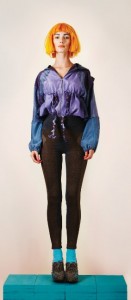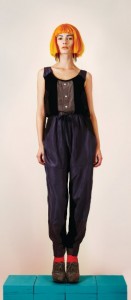
“Innovatively combining new British and sustainable fabrics with reclaimed textiles” – this is Goodone‘s raison d’etre in their own words. The brand has shown at London Fashion Weeks, ships to geographies as far off as Japan, and have managed to make their mark on the main stream through a collaboration with Tesco in the retailer’s Sri Lankan manufacturing site.
The garment upcycling scene though, certainly the one in the UK where it was doing rather well in the last few years at least as far as public perception is concerned, is in a transition. Brands move studios (Junky Styling), some change strategies (From Somwhere), and others move forward and innovate further. Goodone’s most recent initiative belongs in this last category: By setting up a proper upcycling factory that can cope with both, pre- and post-consumer waste, and is the first ‘streamlined’ upcycling facility equipped and ready to work with designers on something more than one-offs.
Shirahime was allowed to interview the Goodone designers Nin Castle and Clare Farell about this new Goodone venture.
 Shirahime: Where did the idea for such a factory emerge? Why an upcycling factory?
Shirahime: Where did the idea for such a factory emerge? Why an upcycling factory?
Goodone: We have been doing upcycling with our own label since its inception 2006, originally making use solely of post consumer textiles, and have worked with this and other challenging sources of materials for a long time now. After two challenging but equally rewarding years collaborating with Tesco, we decided that there was a real need to support large companies in re-incorporating clothing waste back into their manufacturing process. With this project we want to facilitate this and make it all easy/er for them.
Of course, we also want to lead by example and prove that textile waste is a valid resource. There is certainly a lot of interest in this area ‘out there’, but most of the fashion and clothing companies don’t know where and how to start – just full sacks of jumpers at the beginning of the season obviously don’t do the job just yet. The reality is: there is no greener fabric than the one which already exists. The more fibre we can keep in circulation the better it is for us as a global society: less going to landfill, and certainly less strain on the environment through the textile industry as a portion of the raw material exists already and does not have to be produced first.
Shirahime: Can you spell out the environmental – possibly even social – benefits of your factory in detail, maybe with the help of an example?
Goodone: We have always had an environmental focus ahead of social benefits, mostly because as far as we are concerned, we absolutely think and consider it a given that people are treated and paid fairly for their work. As such we are concentrating on making it a commercially viable facility to upcycle waste textiles and this is challenge enough. We are also aiming to recycle all of our cutting waste too.
 Shirahime: The factory is located in Bulgaria – why specifically there? Why not in the UK?
Shirahime: The factory is located in Bulgaria – why specifically there? Why not in the UK?
Goodone: We proudly produced everything in the UK until 2011 but we realised we were fighting against people who by going abroad have less than half of the labour cost we face while producing in the UK. It is impossible to compete with such prices on a high street level.
At the same time, we feel strongly that our biggest impact can be made on the high street. Which means of course, we had to find ways to realise our vision while remaining competitive on a price level. Bulgaria offered us the opportunity to have access to a skilled workforce, within Europe – hence, where we can make sure to keep a tight control on quality, the manufacturing process, but also the labour conditions – at a price that is competitive and affordable.
Shirahime: Did you have to train your factory workers? If so, what kind, and how did you go about doing that – not the least language wise?
Goodone: We are partnered with a friend in Bulgaria who used to work for us. Her English is much better than our Bulgarian! She manages operations, and we keep close contact and make regular visits. For now, we do not need large number of specially trained staff, but in the event of a large scale-up we would stay out there to help with the training of the new employees.
Shirahime: From what I understand, the factory can cope with both, pre- as well as post consumer clothing waste. How does that work practically?
Goodone: Our aim is to optimise the use of the source material, and lay as little hand on it as possible. The primary goal hereby is to maintain the source material as close as possible to its original, which means it potentially could well have at least one more life if a garment produce at the factory were to pass through it again in the future. Of course this also means less labour, lower production costs, and hence a more competitive price-value ratio.
For that reason we categorise and sort by use and colour and then cut each type of piece in bulk batches. We do not fully deconstruct garments, as that can result in more wasted time and fibre.
 Shirahime: Where does the raw material you work with in the factory come from? Are there any collaborations in place that guarantee a steady supply of quality pre- and post consumer waste?
Shirahime: Where does the raw material you work with in the factory come from? Are there any collaborations in place that guarantee a steady supply of quality pre- and post consumer waste?
Goodone: We have recently met a senior representative of a textile recycling company processing 1 billion tonnes of waste textiles a year! The largest in the world I think, so we have access to quite a lot through that. Also because of the size of the operation they grade things much more thoroughly than the usual recycling factory so we can get more specific stock. Previously we have sourced everything in the UK but we now have access to more waste in Europe.
Shirahime: What were the highlights and challenges you encountered when putting the puzzle pieces in place for the factory to function? What lessons were learned?
Goodone: We have learned many, if not most of the lessons already here in the UK through the work on our own collections. 3 years ago we had to find ways how to work with existing factories in the UK – at that stage a lot of trial and error was taking place, which now of course makes the launch of this new venture much smoother. One important lesson learned this time around, and due to that we’re working across borders now, is make sure to be aware of when the different national holidays are – this can be a major scheduling headache!
Things are still developing though, and we like to view the design as well as manufacturing process as continuously evolving. One major highlight always is visiting Bulgaria and seeing our dear friend. And also when we have had meetings with some huge retailers and brands recently – nothing ready for the news yet though, unfortunately!
Shirahime: You consciously give other designers access to the factory, and work with them to realise their collections. How does the collaboration process work?
Goodone: We have set things up with flexibility high on the priority list and we have absolutely no minimums. Of course, for short orders the price will reflect how long the set up takes to get everything ready and up and running. At present we can produce a run of up to around 5000 pieces and lead times on this would be a couple of months.
For as far as collaborations are concerned: Our approach has always been one which embraces it. We feel strongly that it is better to work with larger companies and other designers, rather than against them. Even if we oppose their views. If you don’t like something, the only solution is to try and make it better. That’s why we want to make our high streets a better ‘fashion’ place in every sense of the word – we don’t like the current state very much!
Shirahime: Besides your own collections, which other collections ‘Made at One Good Factory’ will we see come September?
Goodone: We have picked up clients quite quickly and we are currently sampling for most of them. There is a collection for a textile recycling charity currently into production, but otherwise it’s early in the season and we are pending confirmed orders for AW12.

